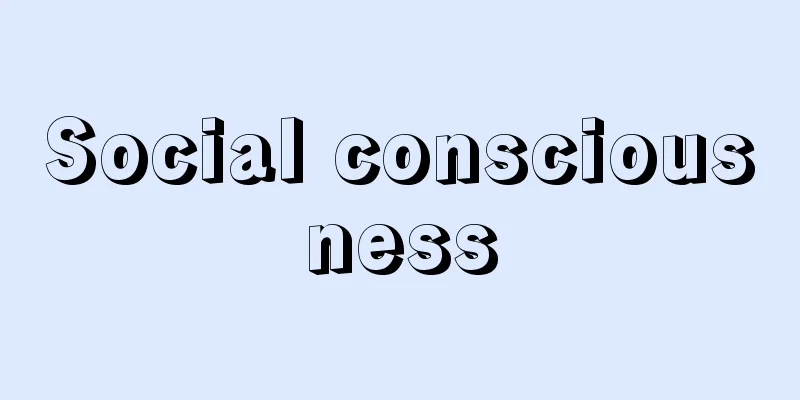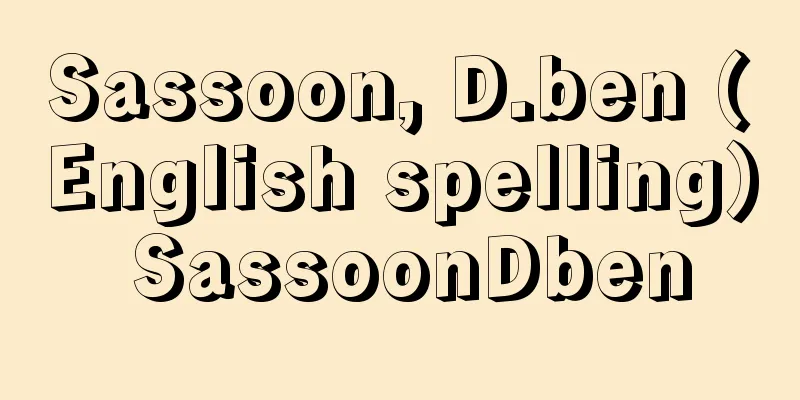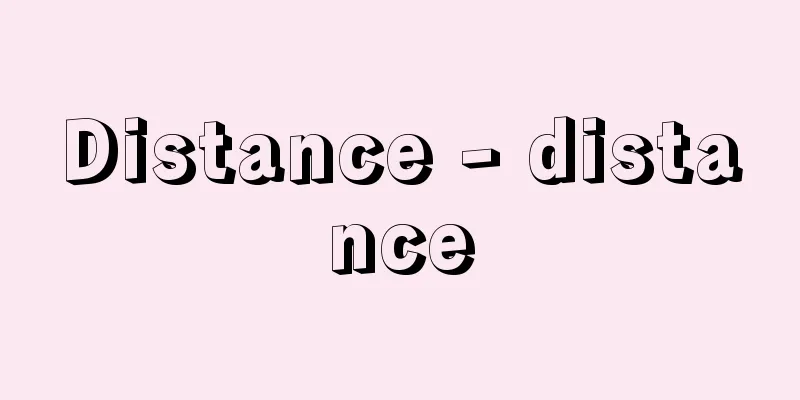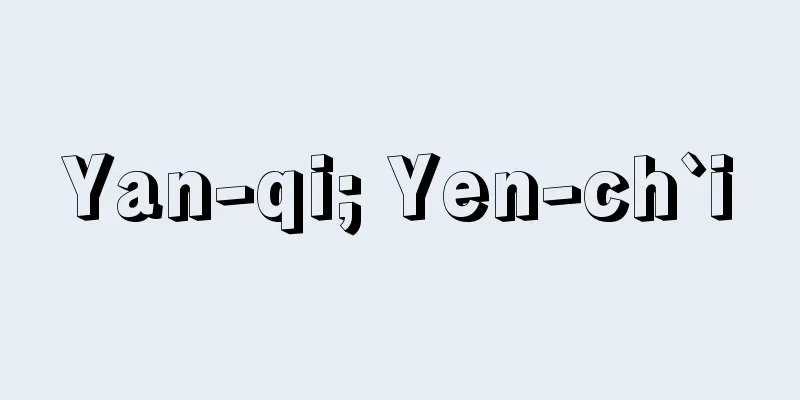Social consciousness

|
It means the mental processes and images (the totality of shared modes of thinking, feeling, and will) that are formed by various classes, strata, ethnic groups, generations, and other social groups, as determined by their respective conditions of existence, and that act as a force for maintaining or transforming those conditions. Social consciousness in the broad sense consists of three components: (1) individual consciousness (which can also be seen as self-consciousness or existential consciousness), (2) life consciousness (the consciousness of everyday life that arises from people's life processes), and (3) social consciousness in the narrow sense (social psychology and ideological forms). [Yoshihisa Tanaka] Individual consciousnessIndividual consciousness is a complex of realistic or unrealistic attitudes that develop in the immediate space and time of people's consciousness. As the literature of Proust and Joyce, and the psychoanalysis of Freud and Lacan make clear, individual consciousness is, firstly, a consciousness that is established based on the determinacy of the time coordinate axes of "past," "present," and "future" for people's ego and existence, and secondly, a consciousness that is created by the projection of the network of various human and social relationships onto the physicality of individuals. Analytically, it can be understood by the elucidation of attitudes through psychology and psychiatry, but in the context of understanding meaning, it needs to be elucidated comprehensively, taking into account the breadth and direction of the individual's life world, values and beliefs, and attitude toward life and death. [Yoshihisa Tanaka] Lifestyle consciousnessLife consciousness is a consciousness that is rooted in and generated from the concrete life process in people's living space and time. The life process includes various social actions of people in four areas: (1) natural reproduction such as eating and sleeping, (2) social reproduction such as labor and housework, (3) mental production and consumption such as communication, and (4) self-restoration such as leisure, and includes the social relations that are formed from them. Therefore, life consciousness is a consciousness that is extremely influenced by gender (male and female) and age groups (children, young adults, middle-aged people, and elderly people), and changes according to people's life stages. In particular, the distribution of institutionalized and non-institutionalized consciousness in relation to the institutional norms of a society will be a key point when analyzing this life consciousness. [Yoshihisa Tanaka] Social consciousness in the narrow senseSocial consciousness in the narrow sense consists of social psychology and ideological forms, all of which are external to individuals and have the characteristic of being binding. Here, social psychology is the totalized expression of thoughts, emotions, and wills shared by a society or group, and ideological forms are more or less systematized ideas such as law, religion, and art. Therefore, social consciousness in the narrow sense, which consists of these social psychology and ideological forms, is certainly external to and binding on individual consciousness and life consciousness, as seen in Durkheim's collective representation. However, at the same time, we must not overlook the fact that there is a close internal connection between these three levels of individual consciousness, life consciousness, and social consciousness in the narrow sense, and that there exists a circuit of a "circulation of meaning." And at all three levels, the point made by Marx and Engels (The German Ideology, 1845-46) that "consciousness is conscious existence" is extremely important. Being is nothing other than a social act in people's lifeworld and the bundle of social relations that arise from it. [Yoshihisa Tanaka] "Modern Ideology" by Hidaka Rokuro (1960, Keiso Shobo) " ▽ "The Theory of Social Consciousness" by Tanaka Yoshihisa (1978, Keiso Shobo)" ▽ "The Structure of Social Consciousness" by Kido Kotaro (1970, Shinyosha)" ▽ "The German Ideology" by K. Marx and F. Engels, translated by Kozai Yoshishige (Iwanami Bunko)" [References] | | | | |Source: Shogakukan Encyclopedia Nipponica About Encyclopedia Nipponica Information | Legend |
|
さまざまな階級、階層、民族、世代その他の社会集団が、それぞれの存在諸条件に規定されつつ形成し、それぞれの存在諸条件を維持し、あるいは変革するための力として作用するものとしての、精神的な諸過程と諸形象(共有された思考、感情、意志の諸様式の総体)を意味する。広義の社会意識は、(1)個人意識(自我意識もしくは実存意識としてとらえられる場合もある)、(2)生活意識(人々の生活過程から生成する日常性の意識)、(3)狭義の社会意識(社会心理とイデオロギー諸形態)、という三つの構成要素からなる。 [田中義久] 個人意識個人意識は、人々の意識にとっての即自的な空間と時間のなかで展開される現実的もしくは非現実的な態度の複合体complexである。プルーストやジョイスの文学、あるいはフロイトやラカンの精神分析が明らかにしているように、個人意識は、第一に、人々の自我や実存に対する「過去」「現在」「未来」という時間の座標軸の規定性のもとに成立する意識であり、第二に、人々の個体としての身体性に対するさまざまな人間関係、社会関係の網の目の投影によって生み出される意識である。それは、分析的には、心理学や精神医学による態度の解明によってとらえられるが、意味理解の文脈からすれば、その個人の生活世界の広がりや方向づけ、価値や信念、生と死に対する構えなどを加味して、総合的に解明されることを必要とする。 [田中義久] 生活意識生活意識は、人々の生活空間と生活時間のなかでの、それぞれに具体的な生活過程に根ざし、そこから生成してくる意識である。生活過程とは、(1)食事・睡眠などの自然的再生産、(2)労働・家事などの社会的再生産、(3)コミュニケーションなどの精神的生産・消費、(4)レジャーなどの自己回復、という四つの領域における人々のさまざまな社会的行為を内容とし、そこから形成されてくる社会諸関係を含むものである。したがって、生活意識は、男性と女性という性別、少年・青年・中年・老年などの年齢層の影響をきわめて強く受けている意識であり、人々のライフ・ステージに対応して変化するものである。とくに、その社会の制度的規範との関係において、制度化された意識と非制度化された意識の分布が、この生活意識を分析する場合のポイントとなるであろう。 [田中義久] 狭義の社会意識狭義の社会意識は、社会心理とイデオロギー諸形態とからなり、いずれも諸個人に対して外在的であり、また、拘束性を有するという特色をもつ。ここで、社会心理とは、ある社会や集団に共有された思考、感情、意志の総体化された表現であり、イデオロギー諸形態とは、法律、宗教、芸術などの多少とも体系化された観念である。したがって、これらの社会心理やイデオロギー諸形態からなる狭義の社会意識は、デュルケームの集合表象にみられるように、個人意識や生活意識に対して、確かに外在的であり、それらに対する拘束性をもつものである。ただし、同時に、これら個人意識、生活意識および狭義の社会意識という三つのレベルの間には緊密な内面的連関があり、一つの「意味の循環」の回路が存在することを看過してはならない。 そして、これら三つのレベルのすべてにおいて、「意識das Bewußtsein(ドイツ語)とは、意識された存在das bewußte Sein(ドイツ語)のことである」というマルクスとエンゲルスの指摘(『ドイツ・イデオロギー』1845~46)は、きわめて重要である。存在とは、人々の生活世界のなかでの社会的行為であり、そこから生成される社会諸関係の束にほかならない。 [田中義久] 『日高六郎著『現代イデオロギー』(1960・勁草書房)』▽『田中義久著『社会意識の理論』(1978・勁草書房)』▽『城戸浩太郎著『社会意識の構造』(1970・新曜社)』▽『K・マルクス、F・エンゲルス著、古在由重訳『ドイツ・イデオロギー』(岩波文庫)』 [参照項目] | | | | |出典 小学館 日本大百科全書(ニッポニカ)日本大百科全書(ニッポニカ)について 情報 | 凡例 |
Recommend
Kan'ei culture
This culture was centered on the Kan'ei era (1...
Museum of Modern Japanese Literature
This museum is both a library and a museum specia...
Agura (sitting position) - Agura
…Therefore, between its origin and insertion, it ...
Ruijukarin - Ruijukarin
A collection of poems compiled by Yamanoue no Oku...
Yoshiakira Ashikaga
Year of death: 6th year of the Sadaharu era/7th De...
The Siege of Odawara
In 1590 (Tensho 18), Toyotomi Hideyoshi attacked ...
Flock - herd
Generally, a group of individual animals is calle...
Ando-so
…The town was established in 1986. The town name ...
Kanjin Kogyo - Promotion of financial support
A form of large-scale entertainment held to raise ...
Imperial gallon
...Its size differs between the UK and the US. (1...
Cassia fistula (English spelling)
…[Mitsuru Hotta] [Aya Nitta]. … *Some of the term...
thyrsos
...He was persecuted by Lycurgus, king of the Edo...
Pomorie
…The Thracians who lived in this area later found...
Assy
…Religious themes such as the Holy Face, along wi...
Immunity (English spelling)
The word "immunity" in "immunity&q...









